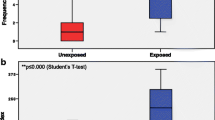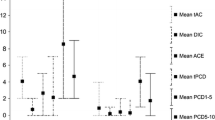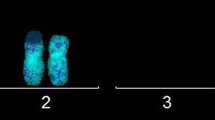Abstract
The focal aim of this study was to assess the frequency of chromosomal aberrations (CA) including chromatid type aberrations (CTA) and chromosomal type aberrations (CSA), micronucleus (MN) and XRCC1 399 Arg/Gln polymorphism in the peripheral blood lymphocytes of 27 petrol pump workers and same number of controls to explore the possible cytogenetic risk on occupational exposure to petrol vapors. The exposed subjects and controls were classified into two groups based on their age (group I < 40 years; group II > 40 years) apart from the classification of the exposed subjects based on their exposure duration (> 8 and < 8 years). CTA and MN frequency were significantly higher in petrol pump workers (p < 0.05) with longer work duration. CTA was found to increase with age in the exposed subjects as well as controls, with exposed subjects showing a statistically higher degree. This effect was not observed in MN. A significantly higher frequency of MN was observed in the smoking petrol pump workers than in control smokers (p < 0.05). No association was found between smoking and CA in both subjects. The study on XRCC1 399 Arg/gln polymorphism in petrol pump workers demonstrated very less difference in allele frequency compared to controls. In conclusion, these datas indicate that petrol pump workers under risk group should be monitored for any long-term adverse effects of the exposure.
Similar content being viewed by others
Explore related subjects
Discover the latest articles, news and stories from top researchers in related subjects.Avoid common mistakes on your manuscript.
Petroleum is a mixture of several hydrocarbons of which, about 95% of the compounds in petrol vapors are aliphatic and alicylic compounds and less than 2% are aromatics (Gupta and Dogra 2002). The volatile nature of petrol makes it readily available in the atmosphere whenever it is dispensed, especially at petrol filling stations. According to the IARC (1989), exposure to gasoline vapors is stated as carcinogenic to humans (Carere et al.1998). Several epidemiological studies on human populations exposed to petroleum vapors have shown that there is an increased incidence of diseases (Lagorio et al. 1993; Carletti and Romano 2002). Petrol vapor is not safe even when inhaled for a brief period of time during fuelling vehicles (Pranjic et al. 2002), which puts the gas station attendants at more risk by virtue of their occupational exposure.
The CA and MN assays have been used as a sensitive biomarker to evaluate the early effects of genotoxic carcinogens in occupational and environmental settings (Mateuca et al. 2006; Al-Sabti and Metcalfe 1995). Over the last decade, several common polymorphisms in DNA repair genes have been discovered, some of which have been suggested to affect the DNA repair capacity and thus may determine an individual’s susceptibility to carcinogens (Patel et al.1997; Goode et al. 2002). It has been suggested that changes in the XRCC1 protein, mainly in amino acid 399, increases the susceptibility for tumor development via genomic instability (Lei et al. 2002).
Petrol evaporates more readily in tropical countries than in temperate ones (Kesavachandran et al. 2006). In South India, petrol pump attendants are engaged in petrol filling for 8 h a day and do not wear personal protective equipment in the workplace which increases the opportunity for exposure. So far, no study has investigated the effect of petrol fumes exposure on cytogenetic effects and XRCC1 399 Arg/gln genomic stability among the petrol pump workers in South India. The aim of this study was to investigate the relationship between exposure to petroleum hydrocarbons and presence of genetic damages such as MN, CA and DNA damage (PCR-RFLP) in peripheral blood lymphocytes (PBLC) along with the comparison of these frequencies in smokers and nonsmokers, in order to examine the possible effects of smoking in the exposed as well as control subjects.
Materials and Methods
The study was carried out in 27 petrol pump workers from 10 petrol stations in Coimbatore City, South India. The control group consisted of 27 healthy subjects without indication of previous occupational exposure to petroleum derivatives or other agents suspicious of genotoxicity. The exposed subjects and the controls were divided into two groups based on the age (group I < 40 years and group II > 40 years). Exposed subjects were further classified into two groups based on their exposure period (< 8 years and > 8 years). The characteristics of both the subjects are shown in Table 1. Informed written consent was obtained from all the individuals, and the study was conducted in accordance with the guidelines of the Declaration of Helsinki.
Cultures of leucocytes obtained from peripheral blood were set-up as described in the protocol of Moorhead et al. (1960). The chromosomal preparations obtained were stained with Giemsa. From each slide 100 well spread metaphases were scored and analyzed for chromosomal abnormalities as per ISCN norms under the oil-immersion microscope.
Four and one-half ml of whole heparinized blood was incubated in 5 mL RPMI 1,640 with glutamine medium, 1 mL of fetal bovine serum and 0.1 mL of phytohemagglutinin. After 44 h of PHA stimulation, Cytochalasin-B was added to obtain a final concentration of 3 μg/mL. After 72 h of culture the cells were harvested. MN frequency was determined on coded slides in at least 1,000 lymphocytes.
Whole genomic DNA was collected as per the kit protocol (Bangalore Genei-Frozen blood DNA extraction kit) for PCR analyses (Duell et al. 2000). Cleavage with specific endonucleases for each polymorphism was done as follows; MspI for Arg399Gln (Lei et al. 2002).
Statistical analysis was performed with the SPSS 13.0 Windows software. Mean and Standard deviation were calculated using t test. The null hypothesis was rejected at 5% level of significance. Allele frequency was calculated using Hardy-Weinberg equilibrium between the exposed subjects and controls. Odds ratio (OR) and 95% confidence intervals were calculated.
Results and Discussion
Petrol station attendants are occupationally exposed to a wide range of petrol derivatives via absorption through the intact skin or by vapor inhalation. Many studies have reported an increase in the number of CA and MN cells in humans occupationally exposed to petroleum derivatives (Celik and Akbas 2005; Benites et al. 2006). Different genetic end-points, such as sister chromatid exchange (SCE), DNA strand breaks and MN (Bukvic et al. 1998) showed an increased level of cytogenetic damage in the PBLC of workers occupationally exposed to petroleum derivates. In our study, on the basis of exposure time, a significant increase (16.13 ± 4.56; p < 0.05) in CTA frequency was measured only within the group having longer duration of exposure compared to workers with shorter work duration. There are studies reporting increased CA in individuals occupationally exposed to petrol and diesel exhausts fumes (Chitra et al. 2001; Burgaz et al. 2002). Some investigators indicated that numerical or structural CA was increased in workers who had a long-term exposure to benzene (Yardley-Jones et al. 1990). Karahalil et al. (1998) evaluated the presence of MN in PBLC of the workers in petrol engine repair garages. Increased MN frequency was noticed on workers exposed to low concentration of benzene (Bukvic et al. 1998). In the present study higher degree of MN frequency were observed in long-term exposed group (Table 2).
An age-related increase in the aneuploid cells of human lymphocytes has been reported in a number of studies (Nowinski et al. 1990). Moreover, the results of the present study also indicate a role for age in chromosome alterations observed in peripheral blood lymphocytes as noted in the controls (Balachandar et al. 2008). Our study reveals that increase in age increases CTA in both the exposed subjects and controls with a significantly higher in group II exposed subjects (2.94 ± 1.24; p < 0.05) as compared to group II controls. Age had no effect on CSA in both subjects. In the present study, a significant increase in MN and CA were observed in the older age group (Roma Torres et al. 2006).Our study shows a higher degree of MN frequency in group I petrol pump workers compared to group I controls and it is statistically significant(0.55 ± 0.82; p < 0.05). Burgaz et al. (1995) found a significant increase in MN cells in smokers, compared to non smokers. Our findings indicate that cigarette smoking heightens MN, and has no effect on CA. In our result, the effect of smoking was not shown as a statistical difference in CSA and CTA frequency between exposed and controls subjects, but MN frequency among exposed individuals with smoking habit was significantly higher than control smokers. A significant difference (p = 0.000; p < 0.05) in CTA frequency were noticed between exposed and control non smokers whereas in the previously published studies, it was observed that cigarette smoking had no effect on CA and MN frequencies (Celik and Akbas 2005). Bukvic et al. (1998) did not find any association between MN frequencies and smoking habits of workers from a gasoline station in Italy. Surralles et al. (1997) reported that MN frequencies in lymphocytes of workers from a petrochemical industry in Estonia had no influence of smoking.
Investigation of Liu et al. (2006) shows that XRCC1399Arg/Gln polymorphism does not alter the affinity of XRCC1 for polynucleotide kinase/phosphatase-poly ADP-ribose polymerase among benzene exposed workers. Our study highlights that there is no interaction between petrol exposures and XRCC1 399 Arg/Gln polymorphism. Shen et al. (1998) reported a statistically non significant additive interaction between the XRCC1 399Gln allele and PAH-DNA adducts as shown in Table 3.
In conclusion, the present study provides some evidence that petrol exposure may be associated with genotoxic effects on the lymphocytes. This study demonstrates that it is possible to detect human health risks at an early stage using sensitive techniques. It is concluded that petrol pump workers at risk group should be carefully monitored and should take adequate protective measures to prevent long-term effects.
References
Al-Sabti K, Metcalfe CD (1995) Fish micronuclei for assessing genotoxicity in water. Mutat Res 343:121–135
Balachandar V, Lakshman Kumar B, Suresh K, Sasikala K (2008) Evaluation of chromosome aberrations in subjects exposed to environmental tobacco smoke in Tamilnadu, India. Bull Environ Contam Toxicol 81:270–276. doi: 10.1007/s00128-008-9489-3
Benites CI, Amado LL, Vianna RAP, Martino-Roth MG (2006) Micronucleus test on gas attendants. Genet Mol Res 5:45–54
Bukvic N, Bavaro P, Elia G, Cassano F, Fanellin M, Guanti G (1998) Sister chromatid exchange (SCE) and micronucleus (MN) frequencies in lymphocytes of gasoline station attendants. Mutat Res 415:25–33
Burgaz S, Iscan A, Buyukbingol ZK, Bozkurt A, Karakaya AE (1995) Evaluation of micronuclei in exfoliated urothelial cells and urinary thioether excretion of smokers. Mutat Res 335:163–169
Burgaz S, Dermircigil GC, Karahalil B, Karakaya AE (2002) Chromosomal damage in peripheral blood lymphocytes of traffic policemen and taxi drivers exposed to urban air pollution. Chemosphere 47:57–64
Carere A, Antoccia A, Cimini D, Crebelli R, Degrasi F, Leopardi P, Marcon F, Sgura A, Tanzarella C, Zijno A (1998) Genetic effects of petroleum fuels II: analysis of chromosome loss and hyperploidy in peripheral lymphocytes of gasoline station attendants. Environ Mol Mutagen 32:130–138
Carletti R, Romano D (2002) Assessing health risk from benzene pollution in an urban area. Environ Monit Assess 80:135–148
Celik A, Akbas E (2005) Evaluation of sister chromatid exchanges and chromosomal aberration frequencies in peripheral blood lymphocytes of gasoline station attendants. Ecotox Environ Saf 60:106–112
Chitra CK, Vishwanathan H, Deepa E, Rani MVU (2001) Cytogenetic monitoring of men occupationally exposed to airborne pollutants. Environ Pollut 112:391–393
Duell EJ, Wiencke JK, Cheng TJ, Varkonyi A, Zuo ZF, Ashok TDS, Mark EJ, Wain JC, Christiani DC, Kelsey KT (2000) Polymorphisms in the DNA repair genes XRCC1 and ERCC2 and biomarkers of DNA damage in human blood mononuclear cells. Carcinogenesis 21:965–971
Goode EL, Ulrich CM, Potter JD (2002) Polymorphisms in DNA repair genes and associations with cancer risk. Cancer Epidemiol Biomark Prev 11:1513–1530
Gupta S, Dogra TD (2002) Air pollution and human health hazards. Indian J Occup Environ 6:89–93
International Agency for Research on Cancer (IARC) (1989) Occupational exposures in petroleum refining; crude oil and major petroluem fuels. IARC Monogr Eval Carcinog Risks Chem Hum 45:322
Karahalil B, Burgaz S, Fisek G, Karakaya AE (1998) Biological monitoring of young workers exposed to polycyclic aromatic hydrocarbons in engine repair workshops. Mut Res 412:261–269
Kesavachandran C, Rastogi SK, Anand M, Mathur N, Dhawan A (2006) Lung function abnormalities among petrol-pump workers of Lucknow, North India. Curr Sci 90:1178
Lagorio S, Forastiere F, Iavarone I, Vanacore N, Fusel-Ii S, Carere A (1993) Exposure assessment in a historical cohort of filling station attendants. Int J Epidemiol 22:51–56
Lei YC, Hwang SJ, Chang CC, Kuo HW, Luo JC, Chang MJ, Cheng TJ (2002) Effects on sister chromatid exchange frequency of polymorphisms in DNA repair gene XRCC1 in smokers. Mutat Res 519:93–101
Liu T, Mellman DM, Batlips D, Hungerford A (2006) Benzene exposure and oxidative DNA damage: influence of genetic polymorphisms in metabolism genes. Toxicol Environ Health 61B:432–443
Mateuca R, Lombaert N, Aka PV, Decordier I, Kirsch-Volders M (2006) Chromosomal changes: induction, detection methods and applicability in human biomonitoring. Biochimie 88:1515–1531
Moorhead PS, Novell WJ, Mellman DM, Batlips D, Hungerford A (1960) Chromosome preparations of leukocytes cultured from peripheral blood. Exp Cell Res 20:613–616
Nowinski GP, Van Dyke DL, Tilley BC, Jacobsen G, Babu VR, Worsham MJ, Wilson GN, Weiss L (1990) The frequency of aneupboidy in cultured lymphocytes is correlated with age and gender but not with reproductive history. Am J Hum Genet 46:1101–1111
Patel RK, Trivedi AH, Arora DC, Bhatavdekar JM, Patel DD (1997) DNA repair proficiency in breast cancer patients and their first-degree relatives. Int J Cancer 73:20–24
Pranjic N, Mujagic H, Nurkic M, Karamehic J, Pavlovic S (2002) Assessment of health effects in workers at gasoline station. Bosn J Basic Med Sci 2:35–45
Roma Torres J, Teixeira JP, Silva S, Laffon B, Cunha LM, Mendez J, Mayan O (2006) Evaluation of genotoxicity in a group of workers from a petroleum refinery aromatics plant. Mutat Res 604:19–27
Shen M, Jones I, Mohrenweiser H (1998) Nonconservative amino acid substitution variants exist at polymorphic frequency in DNA repair genes in healthy humans. Cancer Res 58:604–608
Surralles J, Autio K, Nylund L, Jarventaus H, Norppa H, Veidebaum T, Sorsa M, Peltonen K (1997) Molecular cytogenetic analysis of buccal cells and lymphocytes from benzene-exposed workers. Carcinogenesis 18:817–823
Yardley-Jones A, Anderson D, Lovell DP, Jenkinson PC (1990) Analysis of chromosomal aberrations in workers exposed to low level benzene. Br J Ind Med 47(1):48–51
Acknowledgments
The authors thank the Management of Bharathiar University and Karpagam University for providing infrastructure facilities for this research work and the subjects who volunteered to take part in this study.
Author information
Authors and Affiliations
Corresponding author
Rights and permissions
About this article
Cite this article
Bindhya, S., Balachandar, V., Sudha, S. et al. Assessment of Occupational Cytogenetic Risk, Among Petrol Station Workers. Bull Environ Contam Toxicol 85, 121–124 (2010). https://doi.org/10.1007/s00128-010-0068-z
Received:
Accepted:
Published:
Issue Date:
DOI: https://doi.org/10.1007/s00128-010-0068-z




